Organizational Behavior: Influence, Motivation & Effective Teams
VerifiedAdded on 2023/06/17
|16
|5161
|351
Report
AI Summary
This report provides an analysis of organizational behavior within Tesco, focusing on how organizational culture, politics, and power influence individuals and teams. It evaluates content and process theories of motivation, including Maslow's hierarchy, ERG theory, Herzberg's theory, Adam's equity theory, and Skinner's reinforcement theory, to understand how Tesco can effectively motivate its employees. The report also explains the characteristics of effective teams and contrasts them with ineffective teams, utilizing Tuckman's 5 stages of team development to illustrate team dynamics. Ultimately, the report aims to apply organizational behavior concepts to improve team performance and overall organizational effectiveness within Tesco.
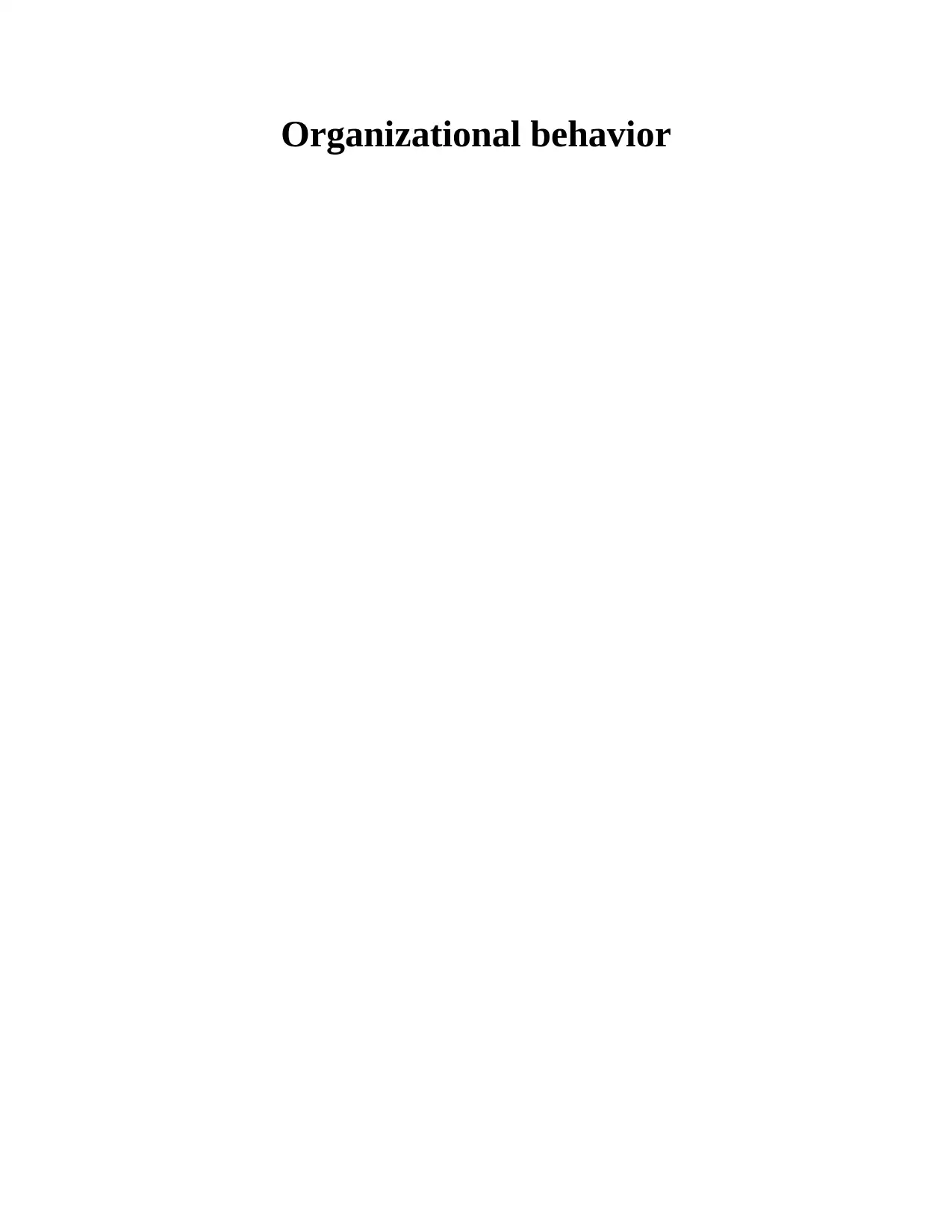
Organizational behavior
Paraphrase This Document
Need a fresh take? Get an instant paraphrase of this document with our AI Paraphraser
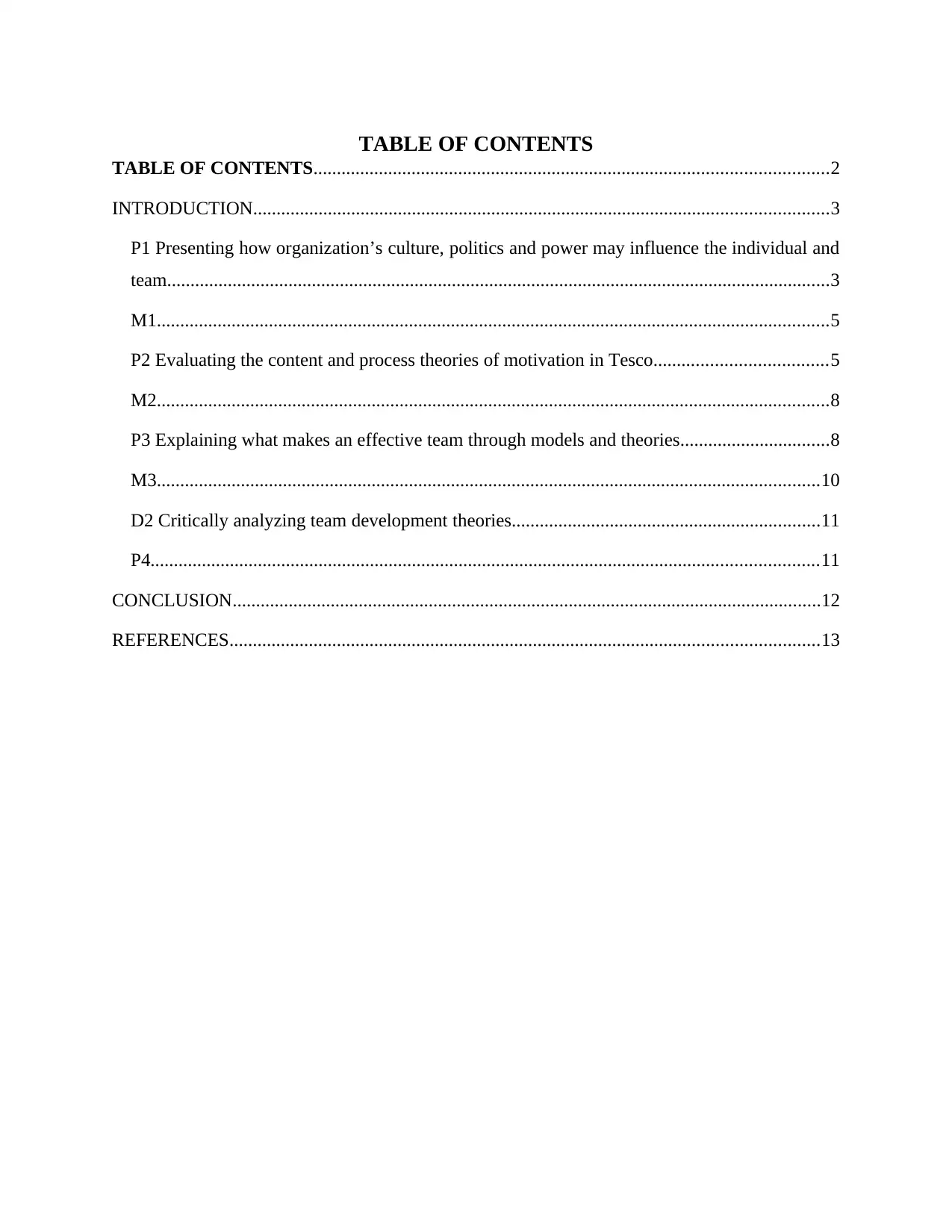
TABLE OF CONTENTS
TABLE OF CONTENTS..............................................................................................................2
INTRODUCTION...........................................................................................................................3
P1 Presenting how organization’s culture, politics and power may influence the individual and
team..............................................................................................................................................3
M1................................................................................................................................................5
P2 Evaluating the content and process theories of motivation in Tesco.....................................5
M2................................................................................................................................................8
P3 Explaining what makes an effective team through models and theories................................8
M3..............................................................................................................................................10
D2 Critically analyzing team development theories..................................................................11
P4...............................................................................................................................................11
CONCLUSION..............................................................................................................................12
REFERENCES..............................................................................................................................13
TABLE OF CONTENTS..............................................................................................................2
INTRODUCTION...........................................................................................................................3
P1 Presenting how organization’s culture, politics and power may influence the individual and
team..............................................................................................................................................3
M1................................................................................................................................................5
P2 Evaluating the content and process theories of motivation in Tesco.....................................5
M2................................................................................................................................................8
P3 Explaining what makes an effective team through models and theories................................8
M3..............................................................................................................................................10
D2 Critically analyzing team development theories..................................................................11
P4...............................................................................................................................................11
CONCLUSION..............................................................................................................................12
REFERENCES..............................................................................................................................13
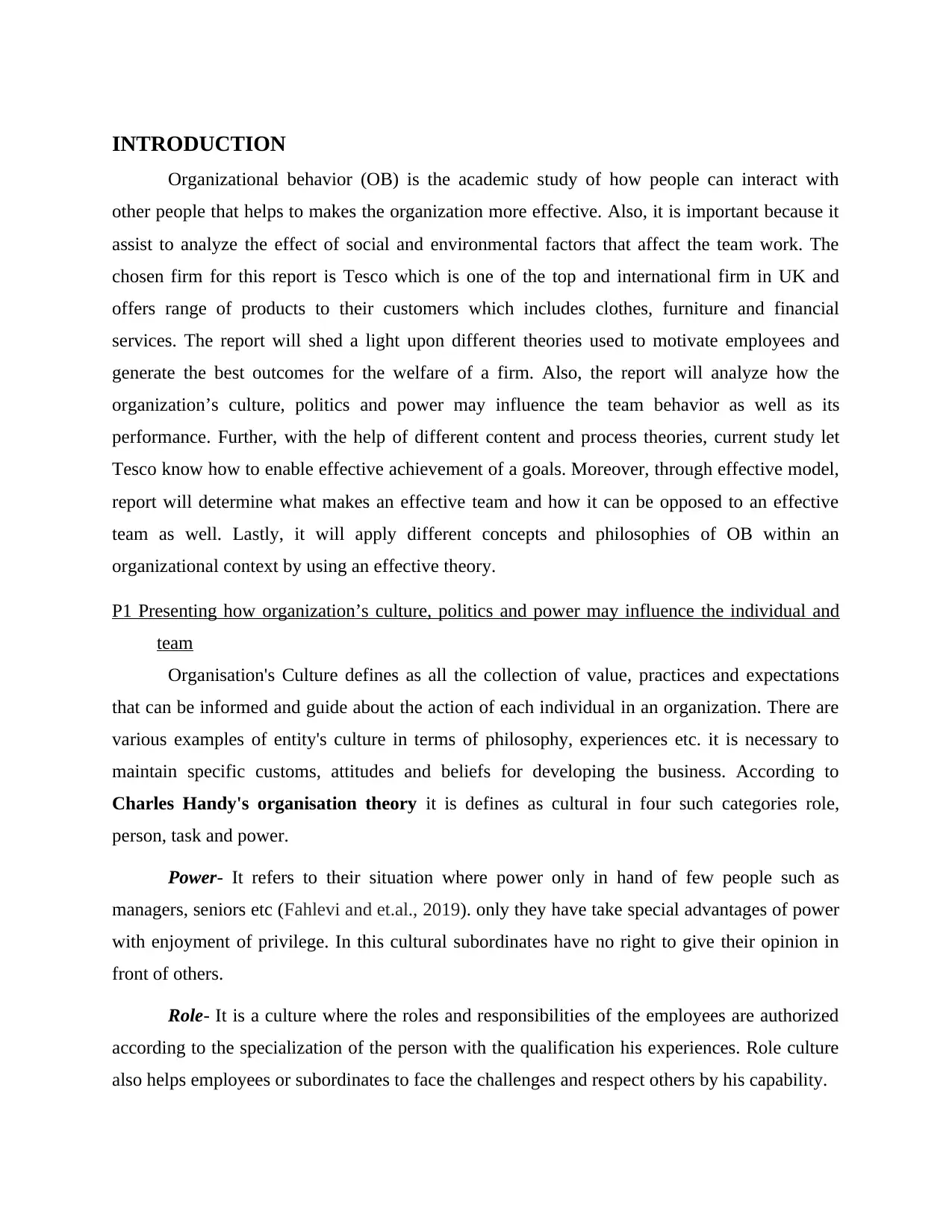
INTRODUCTION
Organizational behavior (OB) is the academic study of how people can interact with
other people that helps to makes the organization more effective. Also, it is important because it
assist to analyze the effect of social and environmental factors that affect the team work. The
chosen firm for this report is Tesco which is one of the top and international firm in UK and
offers range of products to their customers which includes clothes, furniture and financial
services. The report will shed a light upon different theories used to motivate employees and
generate the best outcomes for the welfare of a firm. Also, the report will analyze how the
organization’s culture, politics and power may influence the team behavior as well as its
performance. Further, with the help of different content and process theories, current study let
Tesco know how to enable effective achievement of a goals. Moreover, through effective model,
report will determine what makes an effective team and how it can be opposed to an effective
team as well. Lastly, it will apply different concepts and philosophies of OB within an
organizational context by using an effective theory.
P1 Presenting how organization’s culture, politics and power may influence the individual and
team
Organisation's Culture defines as all the collection of value, practices and expectations
that can be informed and guide about the action of each individual in an organization. There are
various examples of entity's culture in terms of philosophy, experiences etc. it is necessary to
maintain specific customs, attitudes and beliefs for developing the business. According to
Charles Handy's organisation theory it is defines as cultural in four such categories role,
person, task and power.
Power- It refers to their situation where power only in hand of few people such as
managers, seniors etc (Fahlevi and et.al., 2019). only they have take special advantages of power
with enjoyment of privilege. In this cultural subordinates have no right to give their opinion in
front of others.
Role- It is a culture where the roles and responsibilities of the employees are authorized
according to the specialization of the person with the qualification his experiences. Role culture
also helps employees or subordinates to face the challenges and respect others by his capability.
Organizational behavior (OB) is the academic study of how people can interact with
other people that helps to makes the organization more effective. Also, it is important because it
assist to analyze the effect of social and environmental factors that affect the team work. The
chosen firm for this report is Tesco which is one of the top and international firm in UK and
offers range of products to their customers which includes clothes, furniture and financial
services. The report will shed a light upon different theories used to motivate employees and
generate the best outcomes for the welfare of a firm. Also, the report will analyze how the
organization’s culture, politics and power may influence the team behavior as well as its
performance. Further, with the help of different content and process theories, current study let
Tesco know how to enable effective achievement of a goals. Moreover, through effective model,
report will determine what makes an effective team and how it can be opposed to an effective
team as well. Lastly, it will apply different concepts and philosophies of OB within an
organizational context by using an effective theory.
P1 Presenting how organization’s culture, politics and power may influence the individual and
team
Organisation's Culture defines as all the collection of value, practices and expectations
that can be informed and guide about the action of each individual in an organization. There are
various examples of entity's culture in terms of philosophy, experiences etc. it is necessary to
maintain specific customs, attitudes and beliefs for developing the business. According to
Charles Handy's organisation theory it is defines as cultural in four such categories role,
person, task and power.
Power- It refers to their situation where power only in hand of few people such as
managers, seniors etc (Fahlevi and et.al., 2019). only they have take special advantages of power
with enjoyment of privilege. In this cultural subordinates have no right to give their opinion in
front of others.
Role- It is a culture where the roles and responsibilities of the employees are authorized
according to the specialization of the person with the qualification his experiences. Role culture
also helps employees or subordinates to face the challenges and respect others by his capability.
⊘ This is a preview!⊘
Do you want full access?
Subscribe today to unlock all pages.

Trusted by 1+ million students worldwide
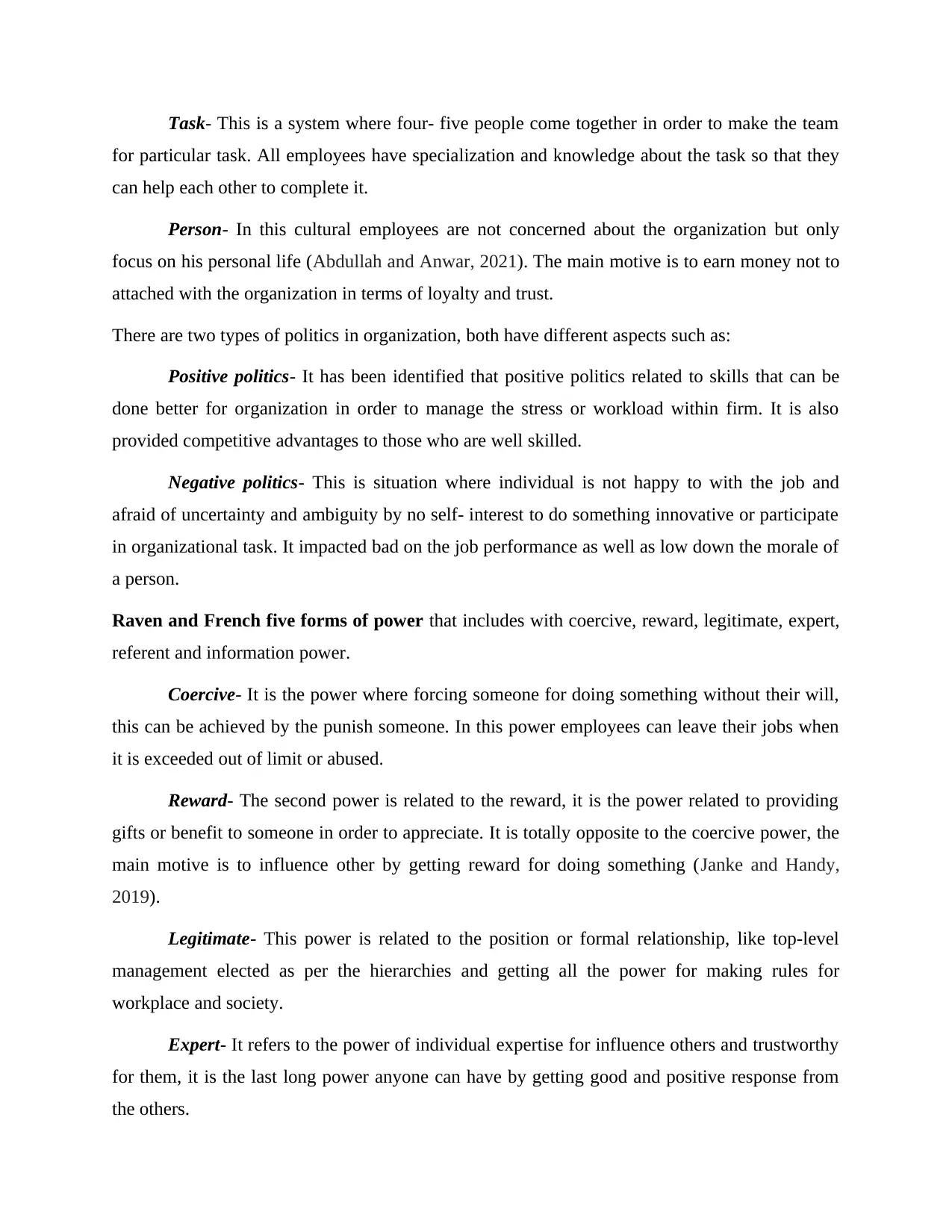
Task- This is a system where four- five people come together in order to make the team
for particular task. All employees have specialization and knowledge about the task so that they
can help each other to complete it.
Person- In this cultural employees are not concerned about the organization but only
focus on his personal life (Abdullah and Anwar, 2021). The main motive is to earn money not to
attached with the organization in terms of loyalty and trust.
There are two types of politics in organization, both have different aspects such as:
Positive politics- It has been identified that positive politics related to skills that can be
done better for organization in order to manage the stress or workload within firm. It is also
provided competitive advantages to those who are well skilled.
Negative politics- This is situation where individual is not happy to with the job and
afraid of uncertainty and ambiguity by no self- interest to do something innovative or participate
in organizational task. It impacted bad on the job performance as well as low down the morale of
a person.
Raven and French five forms of power that includes with coercive, reward, legitimate, expert,
referent and information power.
Coercive- It is the power where forcing someone for doing something without their will,
this can be achieved by the punish someone. In this power employees can leave their jobs when
it is exceeded out of limit or abused.
Reward- The second power is related to the reward, it is the power related to providing
gifts or benefit to someone in order to appreciate. It is totally opposite to the coercive power, the
main motive is to influence other by getting reward for doing something (Janke and Handy,
2019).
Legitimate- This power is related to the position or formal relationship, like top-level
management elected as per the hierarchies and getting all the power for making rules for
workplace and society.
Expert- It refers to the power of individual expertise for influence others and trustworthy
for them, it is the last long power anyone can have by getting good and positive response from
the others.
for particular task. All employees have specialization and knowledge about the task so that they
can help each other to complete it.
Person- In this cultural employees are not concerned about the organization but only
focus on his personal life (Abdullah and Anwar, 2021). The main motive is to earn money not to
attached with the organization in terms of loyalty and trust.
There are two types of politics in organization, both have different aspects such as:
Positive politics- It has been identified that positive politics related to skills that can be
done better for organization in order to manage the stress or workload within firm. It is also
provided competitive advantages to those who are well skilled.
Negative politics- This is situation where individual is not happy to with the job and
afraid of uncertainty and ambiguity by no self- interest to do something innovative or participate
in organizational task. It impacted bad on the job performance as well as low down the morale of
a person.
Raven and French five forms of power that includes with coercive, reward, legitimate, expert,
referent and information power.
Coercive- It is the power where forcing someone for doing something without their will,
this can be achieved by the punish someone. In this power employees can leave their jobs when
it is exceeded out of limit or abused.
Reward- The second power is related to the reward, it is the power related to providing
gifts or benefit to someone in order to appreciate. It is totally opposite to the coercive power, the
main motive is to influence other by getting reward for doing something (Janke and Handy,
2019).
Legitimate- This power is related to the position or formal relationship, like top-level
management elected as per the hierarchies and getting all the power for making rules for
workplace and society.
Expert- It refers to the power of individual expertise for influence others and trustworthy
for them, it is the last long power anyone can have by getting good and positive response from
the others.
Paraphrase This Document
Need a fresh take? Get an instant paraphrase of this document with our AI Paraphraser
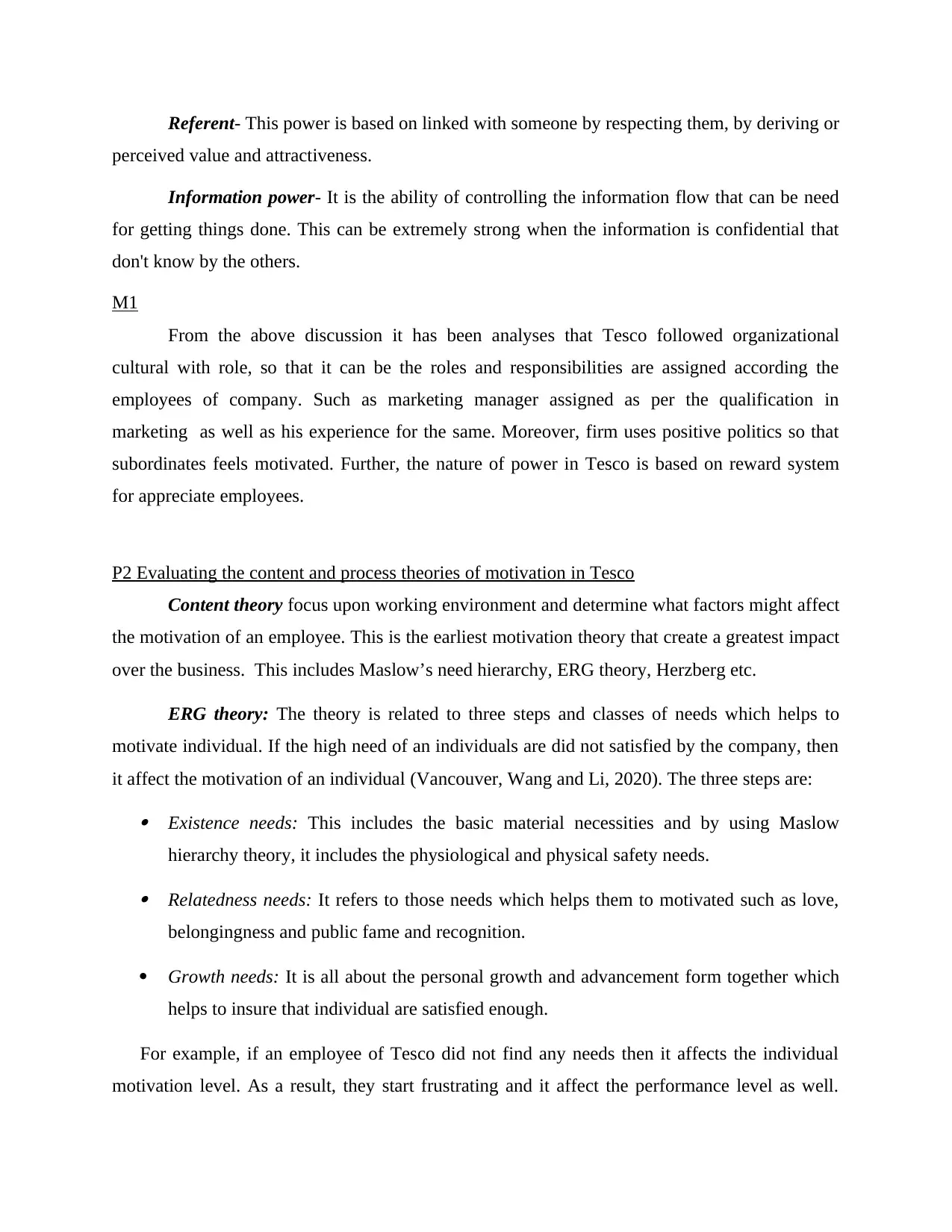
Referent- This power is based on linked with someone by respecting them, by deriving or
perceived value and attractiveness.
Information power- It is the ability of controlling the information flow that can be need
for getting things done. This can be extremely strong when the information is confidential that
don't know by the others.
M1
From the above discussion it has been analyses that Tesco followed organizational
cultural with role, so that it can be the roles and responsibilities are assigned according the
employees of company. Such as marketing manager assigned as per the qualification in
marketing as well as his experience for the same. Moreover, firm uses positive politics so that
subordinates feels motivated. Further, the nature of power in Tesco is based on reward system
for appreciate employees.
P2 Evaluating the content and process theories of motivation in Tesco
Content theory focus upon working environment and determine what factors might affect
the motivation of an employee. This is the earliest motivation theory that create a greatest impact
over the business. This includes Maslow’s need hierarchy, ERG theory, Herzberg etc.
ERG theory: The theory is related to three steps and classes of needs which helps to
motivate individual. If the high need of an individuals are did not satisfied by the company, then
it affect the motivation of an individual (Vancouver, Wang and Li, 2020). The three steps are: Existence needs: This includes the basic material necessities and by using Maslow
hierarchy theory, it includes the physiological and physical safety needs. Relatedness needs: It refers to those needs which helps them to motivated such as love,
belongingness and public fame and recognition.
Growth needs: It is all about the personal growth and advancement form together which
helps to insure that individual are satisfied enough.
For example, if an employee of Tesco did not find any needs then it affects the individual
motivation level. As a result, they start frustrating and it affect the performance level as well.
perceived value and attractiveness.
Information power- It is the ability of controlling the information flow that can be need
for getting things done. This can be extremely strong when the information is confidential that
don't know by the others.
M1
From the above discussion it has been analyses that Tesco followed organizational
cultural with role, so that it can be the roles and responsibilities are assigned according the
employees of company. Such as marketing manager assigned as per the qualification in
marketing as well as his experience for the same. Moreover, firm uses positive politics so that
subordinates feels motivated. Further, the nature of power in Tesco is based on reward system
for appreciate employees.
P2 Evaluating the content and process theories of motivation in Tesco
Content theory focus upon working environment and determine what factors might affect
the motivation of an employee. This is the earliest motivation theory that create a greatest impact
over the business. This includes Maslow’s need hierarchy, ERG theory, Herzberg etc.
ERG theory: The theory is related to three steps and classes of needs which helps to
motivate individual. If the high need of an individuals are did not satisfied by the company, then
it affect the motivation of an individual (Vancouver, Wang and Li, 2020). The three steps are: Existence needs: This includes the basic material necessities and by using Maslow
hierarchy theory, it includes the physiological and physical safety needs. Relatedness needs: It refers to those needs which helps them to motivated such as love,
belongingness and public fame and recognition.
Growth needs: It is all about the personal growth and advancement form together which
helps to insure that individual are satisfied enough.
For example, if an employee of Tesco did not find any needs then it affects the individual
motivation level. As a result, they start frustrating and it affect the performance level as well.
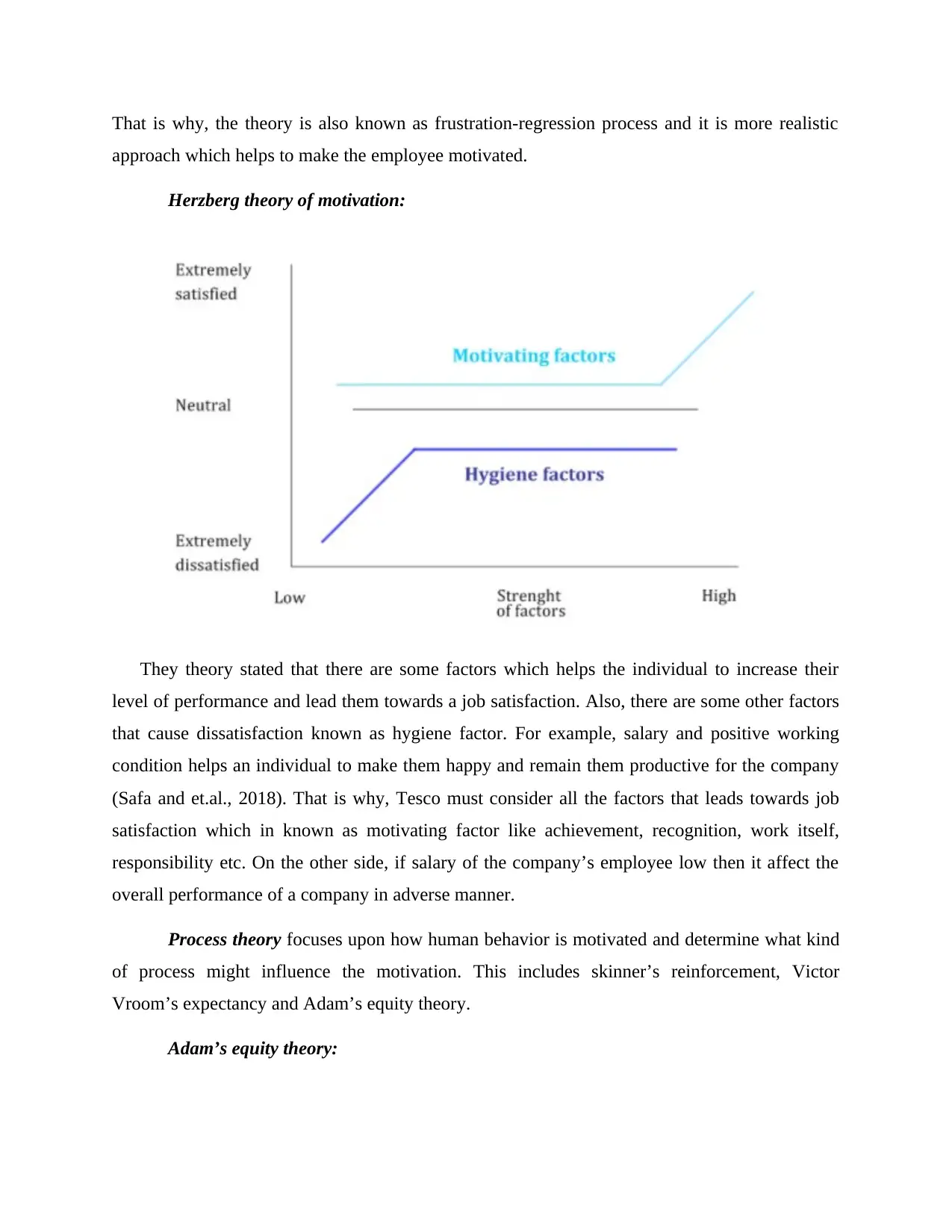
That is why, the theory is also known as frustration-regression process and it is more realistic
approach which helps to make the employee motivated.
Herzberg theory of motivation:
They theory stated that there are some factors which helps the individual to increase their
level of performance and lead them towards a job satisfaction. Also, there are some other factors
that cause dissatisfaction known as hygiene factor. For example, salary and positive working
condition helps an individual to make them happy and remain them productive for the company
(Safa and et.al., 2018). That is why, Tesco must consider all the factors that leads towards job
satisfaction which in known as motivating factor like achievement, recognition, work itself,
responsibility etc. On the other side, if salary of the company’s employee low then it affect the
overall performance of a company in adverse manner.
Process theory focuses upon how human behavior is motivated and determine what kind
of process might influence the motivation. This includes skinner’s reinforcement, Victor
Vroom’s expectancy and Adam’s equity theory.
Adam’s equity theory:
approach which helps to make the employee motivated.
Herzberg theory of motivation:
They theory stated that there are some factors which helps the individual to increase their
level of performance and lead them towards a job satisfaction. Also, there are some other factors
that cause dissatisfaction known as hygiene factor. For example, salary and positive working
condition helps an individual to make them happy and remain them productive for the company
(Safa and et.al., 2018). That is why, Tesco must consider all the factors that leads towards job
satisfaction which in known as motivating factor like achievement, recognition, work itself,
responsibility etc. On the other side, if salary of the company’s employee low then it affect the
overall performance of a company in adverse manner.
Process theory focuses upon how human behavior is motivated and determine what kind
of process might influence the motivation. This includes skinner’s reinforcement, Victor
Vroom’s expectancy and Adam’s equity theory.
Adam’s equity theory:
⊘ This is a preview!⊘
Do you want full access?
Subscribe today to unlock all pages.

Trusted by 1+ million students worldwide
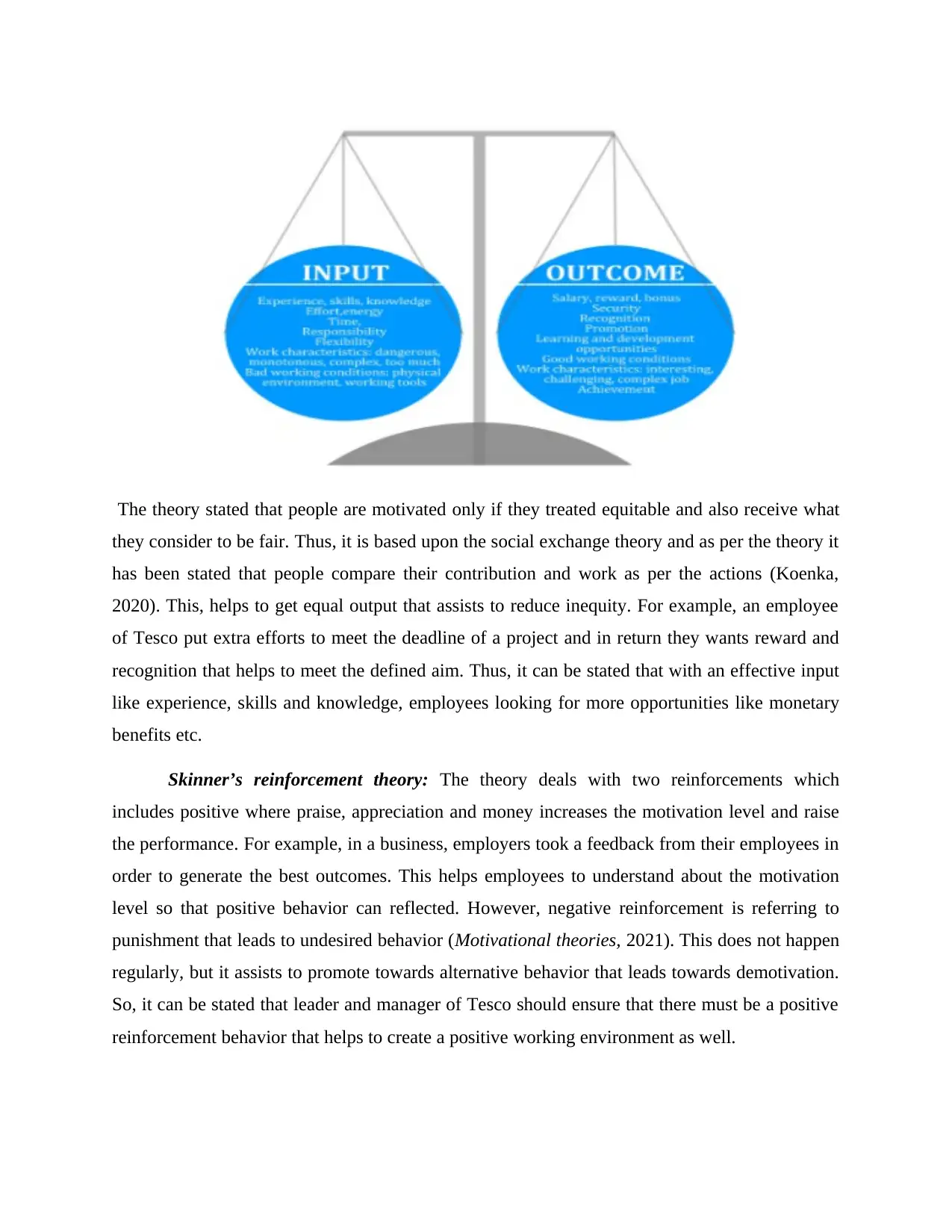
The theory stated that people are motivated only if they treated equitable and also receive what
they consider to be fair. Thus, it is based upon the social exchange theory and as per the theory it
has been stated that people compare their contribution and work as per the actions (Koenka,
2020). This, helps to get equal output that assists to reduce inequity. For example, an employee
of Tesco put extra efforts to meet the deadline of a project and in return they wants reward and
recognition that helps to meet the defined aim. Thus, it can be stated that with an effective input
like experience, skills and knowledge, employees looking for more opportunities like monetary
benefits etc.
Skinner’s reinforcement theory: The theory deals with two reinforcements which
includes positive where praise, appreciation and money increases the motivation level and raise
the performance. For example, in a business, employers took a feedback from their employees in
order to generate the best outcomes. This helps employees to understand about the motivation
level so that positive behavior can reflected. However, negative reinforcement is referring to
punishment that leads to undesired behavior (Motivational theories, 2021). This does not happen
regularly, but it assists to promote towards alternative behavior that leads towards demotivation.
So, it can be stated that leader and manager of Tesco should ensure that there must be a positive
reinforcement behavior that helps to create a positive working environment as well.
they consider to be fair. Thus, it is based upon the social exchange theory and as per the theory it
has been stated that people compare their contribution and work as per the actions (Koenka,
2020). This, helps to get equal output that assists to reduce inequity. For example, an employee
of Tesco put extra efforts to meet the deadline of a project and in return they wants reward and
recognition that helps to meet the defined aim. Thus, it can be stated that with an effective input
like experience, skills and knowledge, employees looking for more opportunities like monetary
benefits etc.
Skinner’s reinforcement theory: The theory deals with two reinforcements which
includes positive where praise, appreciation and money increases the motivation level and raise
the performance. For example, in a business, employers took a feedback from their employees in
order to generate the best outcomes. This helps employees to understand about the motivation
level so that positive behavior can reflected. However, negative reinforcement is referring to
punishment that leads to undesired behavior (Motivational theories, 2021). This does not happen
regularly, but it assists to promote towards alternative behavior that leads towards demotivation.
So, it can be stated that leader and manager of Tesco should ensure that there must be a positive
reinforcement behavior that helps to create a positive working environment as well.
Paraphrase This Document
Need a fresh take? Get an instant paraphrase of this document with our AI Paraphraser
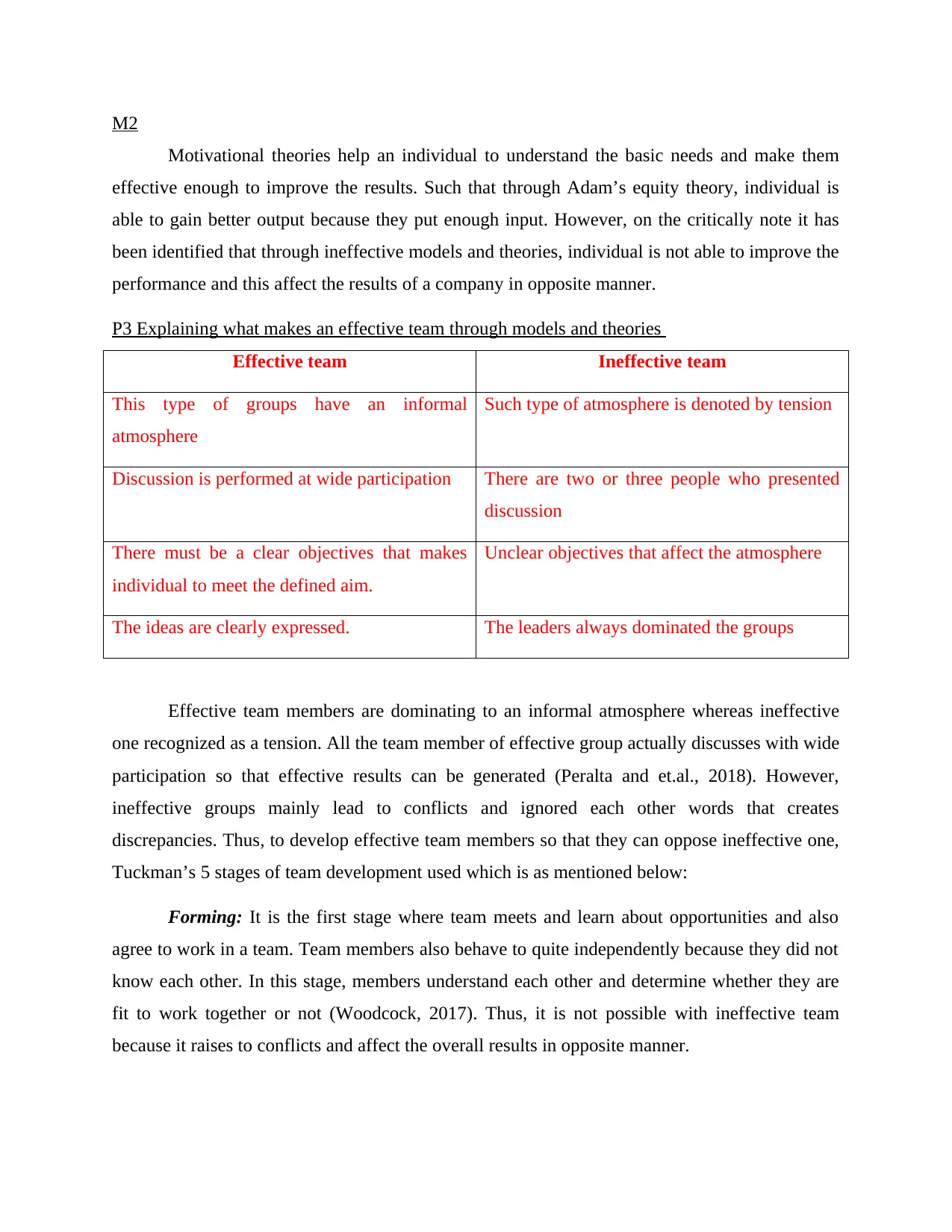
M2
Motivational theories help an individual to understand the basic needs and make them
effective enough to improve the results. Such that through Adam’s equity theory, individual is
able to gain better output because they put enough input. However, on the critically note it has
been identified that through ineffective models and theories, individual is not able to improve the
performance and this affect the results of a company in opposite manner.
P3 Explaining what makes an effective team through models and theories
Effective team Ineffective team
This type of groups have an informal
atmosphere
Such type of atmosphere is denoted by tension
Discussion is performed at wide participation There are two or three people who presented
discussion
There must be a clear objectives that makes
individual to meet the defined aim.
Unclear objectives that affect the atmosphere
The ideas are clearly expressed. The leaders always dominated the groups
Effective team members are dominating to an informal atmosphere whereas ineffective
one recognized as a tension. All the team member of effective group actually discusses with wide
participation so that effective results can be generated (Peralta and et.al., 2018). However,
ineffective groups mainly lead to conflicts and ignored each other words that creates
discrepancies. Thus, to develop effective team members so that they can oppose ineffective one,
Tuckman’s 5 stages of team development used which is as mentioned below:
Forming: It is the first stage where team meets and learn about opportunities and also
agree to work in a team. Team members also behave to quite independently because they did not
know each other. In this stage, members understand each other and determine whether they are
fit to work together or not (Woodcock, 2017). Thus, it is not possible with ineffective team
because it raises to conflicts and affect the overall results in opposite manner.
Motivational theories help an individual to understand the basic needs and make them
effective enough to improve the results. Such that through Adam’s equity theory, individual is
able to gain better output because they put enough input. However, on the critically note it has
been identified that through ineffective models and theories, individual is not able to improve the
performance and this affect the results of a company in opposite manner.
P3 Explaining what makes an effective team through models and theories
Effective team Ineffective team
This type of groups have an informal
atmosphere
Such type of atmosphere is denoted by tension
Discussion is performed at wide participation There are two or three people who presented
discussion
There must be a clear objectives that makes
individual to meet the defined aim.
Unclear objectives that affect the atmosphere
The ideas are clearly expressed. The leaders always dominated the groups
Effective team members are dominating to an informal atmosphere whereas ineffective
one recognized as a tension. All the team member of effective group actually discusses with wide
participation so that effective results can be generated (Peralta and et.al., 2018). However,
ineffective groups mainly lead to conflicts and ignored each other words that creates
discrepancies. Thus, to develop effective team members so that they can oppose ineffective one,
Tuckman’s 5 stages of team development used which is as mentioned below:
Forming: It is the first stage where team meets and learn about opportunities and also
agree to work in a team. Team members also behave to quite independently because they did not
know each other. In this stage, members understand each other and determine whether they are
fit to work together or not (Woodcock, 2017). Thus, it is not possible with ineffective team
because it raises to conflicts and affect the overall results in opposite manner.
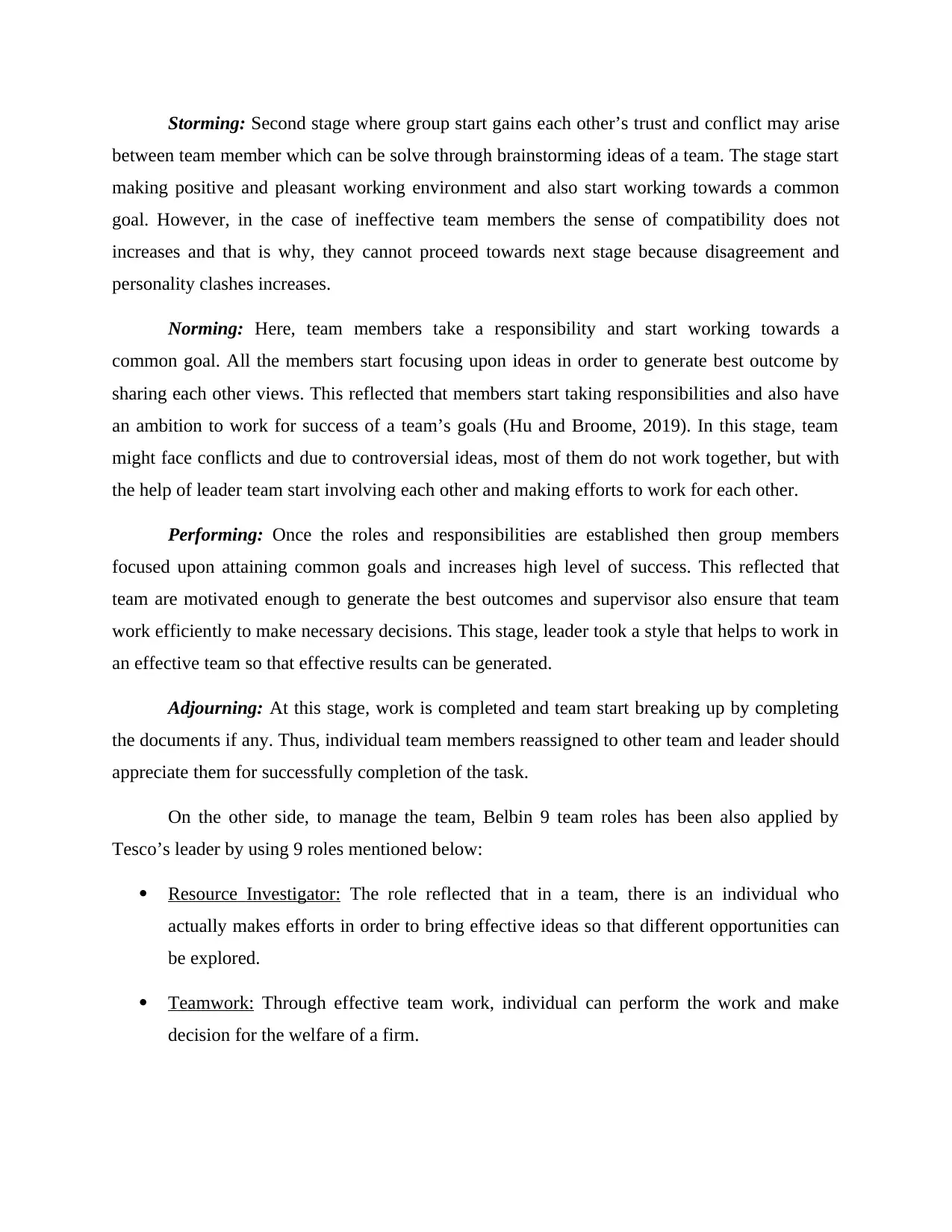
Storming: Second stage where group start gains each other’s trust and conflict may arise
between team member which can be solve through brainstorming ideas of a team. The stage start
making positive and pleasant working environment and also start working towards a common
goal. However, in the case of ineffective team members the sense of compatibility does not
increases and that is why, they cannot proceed towards next stage because disagreement and
personality clashes increases.
Norming: Here, team members take a responsibility and start working towards a
common goal. All the members start focusing upon ideas in order to generate best outcome by
sharing each other views. This reflected that members start taking responsibilities and also have
an ambition to work for success of a team’s goals (Hu and Broome, 2019). In this stage, team
might face conflicts and due to controversial ideas, most of them do not work together, but with
the help of leader team start involving each other and making efforts to work for each other.
Performing: Once the roles and responsibilities are established then group members
focused upon attaining common goals and increases high level of success. This reflected that
team are motivated enough to generate the best outcomes and supervisor also ensure that team
work efficiently to make necessary decisions. This stage, leader took a style that helps to work in
an effective team so that effective results can be generated.
Adjourning: At this stage, work is completed and team start breaking up by completing
the documents if any. Thus, individual team members reassigned to other team and leader should
appreciate them for successfully completion of the task.
On the other side, to manage the team, Belbin 9 team roles has been also applied by
Tesco’s leader by using 9 roles mentioned below:
Resource Investigator: The role reflected that in a team, there is an individual who
actually makes efforts in order to bring effective ideas so that different opportunities can
be explored.
Teamwork: Through effective team work, individual can perform the work and make
decision for the welfare of a firm.
between team member which can be solve through brainstorming ideas of a team. The stage start
making positive and pleasant working environment and also start working towards a common
goal. However, in the case of ineffective team members the sense of compatibility does not
increases and that is why, they cannot proceed towards next stage because disagreement and
personality clashes increases.
Norming: Here, team members take a responsibility and start working towards a
common goal. All the members start focusing upon ideas in order to generate best outcome by
sharing each other views. This reflected that members start taking responsibilities and also have
an ambition to work for success of a team’s goals (Hu and Broome, 2019). In this stage, team
might face conflicts and due to controversial ideas, most of them do not work together, but with
the help of leader team start involving each other and making efforts to work for each other.
Performing: Once the roles and responsibilities are established then group members
focused upon attaining common goals and increases high level of success. This reflected that
team are motivated enough to generate the best outcomes and supervisor also ensure that team
work efficiently to make necessary decisions. This stage, leader took a style that helps to work in
an effective team so that effective results can be generated.
Adjourning: At this stage, work is completed and team start breaking up by completing
the documents if any. Thus, individual team members reassigned to other team and leader should
appreciate them for successfully completion of the task.
On the other side, to manage the team, Belbin 9 team roles has been also applied by
Tesco’s leader by using 9 roles mentioned below:
Resource Investigator: The role reflected that in a team, there is an individual who
actually makes efforts in order to bring effective ideas so that different opportunities can
be explored.
Teamwork: Through effective team work, individual can perform the work and make
decision for the welfare of a firm.
⊘ This is a preview!⊘
Do you want full access?
Subscribe today to unlock all pages.

Trusted by 1+ million students worldwide
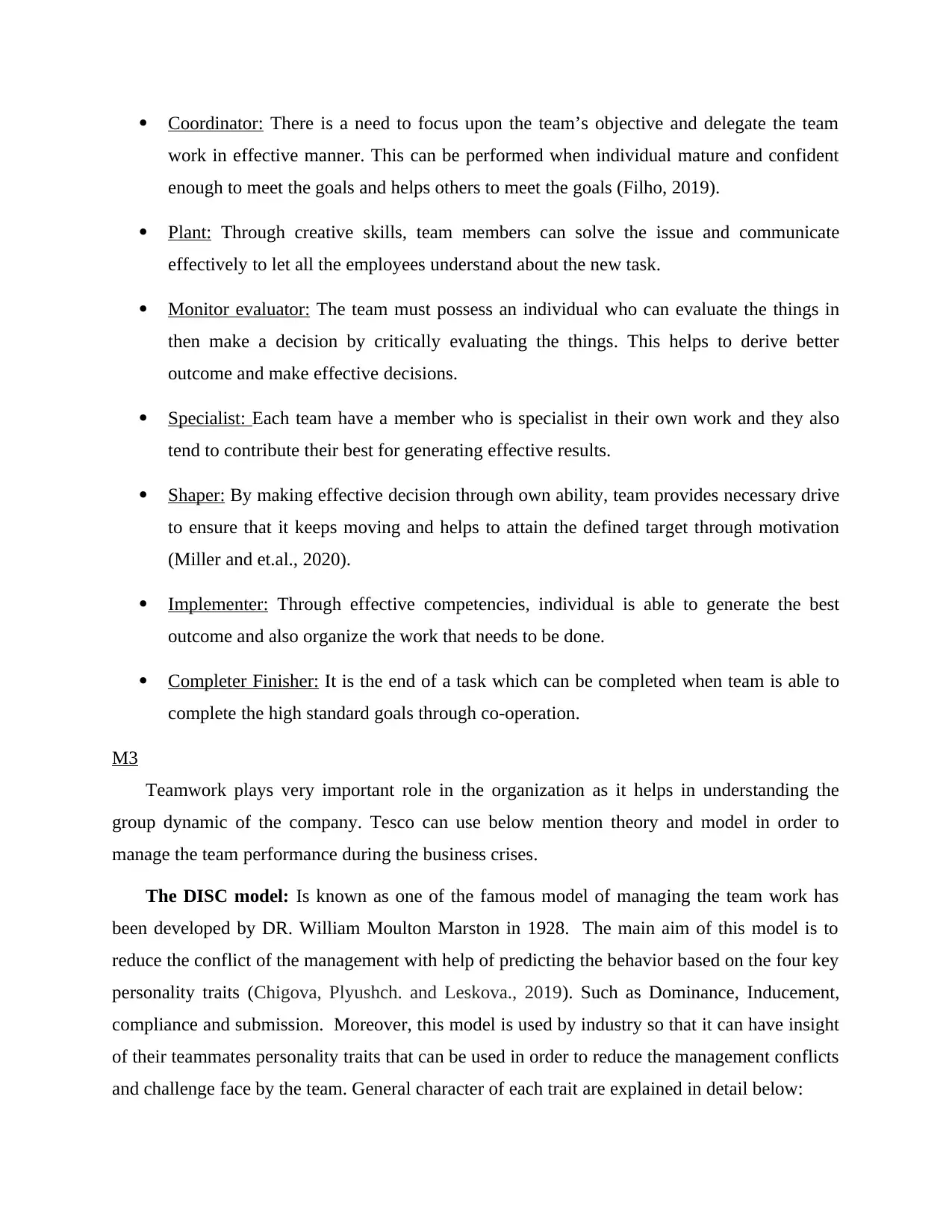
Coordinator: There is a need to focus upon the team’s objective and delegate the team
work in effective manner. This can be performed when individual mature and confident
enough to meet the goals and helps others to meet the goals (Filho, 2019).
Plant: Through creative skills, team members can solve the issue and communicate
effectively to let all the employees understand about the new task.
Monitor evaluator: The team must possess an individual who can evaluate the things in
then make a decision by critically evaluating the things. This helps to derive better
outcome and make effective decisions.
Specialist: Each team have a member who is specialist in their own work and they also
tend to contribute their best for generating effective results.
Shaper: By making effective decision through own ability, team provides necessary drive
to ensure that it keeps moving and helps to attain the defined target through motivation
(Miller and et.al., 2020).
Implementer: Through effective competencies, individual is able to generate the best
outcome and also organize the work that needs to be done.
Completer Finisher: It is the end of a task which can be completed when team is able to
complete the high standard goals through co-operation.
M3
Teamwork plays very important role in the organization as it helps in understanding the
group dynamic of the company. Tesco can use below mention theory and model in order to
manage the team performance during the business crises.
The DISC model: Is known as one of the famous model of managing the team work has
been developed by DR. William Moulton Marston in 1928. The main aim of this model is to
reduce the conflict of the management with help of predicting the behavior based on the four key
personality traits (Chigova, Plyushch. and Leskova., 2019). Such as Dominance, Inducement,
compliance and submission. Moreover, this model is used by industry so that it can have insight
of their teammates personality traits that can be used in order to reduce the management conflicts
and challenge face by the team. General character of each trait are explained in detail below:
work in effective manner. This can be performed when individual mature and confident
enough to meet the goals and helps others to meet the goals (Filho, 2019).
Plant: Through creative skills, team members can solve the issue and communicate
effectively to let all the employees understand about the new task.
Monitor evaluator: The team must possess an individual who can evaluate the things in
then make a decision by critically evaluating the things. This helps to derive better
outcome and make effective decisions.
Specialist: Each team have a member who is specialist in their own work and they also
tend to contribute their best for generating effective results.
Shaper: By making effective decision through own ability, team provides necessary drive
to ensure that it keeps moving and helps to attain the defined target through motivation
(Miller and et.al., 2020).
Implementer: Through effective competencies, individual is able to generate the best
outcome and also organize the work that needs to be done.
Completer Finisher: It is the end of a task which can be completed when team is able to
complete the high standard goals through co-operation.
M3
Teamwork plays very important role in the organization as it helps in understanding the
group dynamic of the company. Tesco can use below mention theory and model in order to
manage the team performance during the business crises.
The DISC model: Is known as one of the famous model of managing the team work has
been developed by DR. William Moulton Marston in 1928. The main aim of this model is to
reduce the conflict of the management with help of predicting the behavior based on the four key
personality traits (Chigova, Plyushch. and Leskova., 2019). Such as Dominance, Inducement,
compliance and submission. Moreover, this model is used by industry so that it can have insight
of their teammates personality traits that can be used in order to reduce the management conflicts
and challenge face by the team. General character of each trait are explained in detail below:
Paraphrase This Document
Need a fresh take? Get an instant paraphrase of this document with our AI Paraphraser
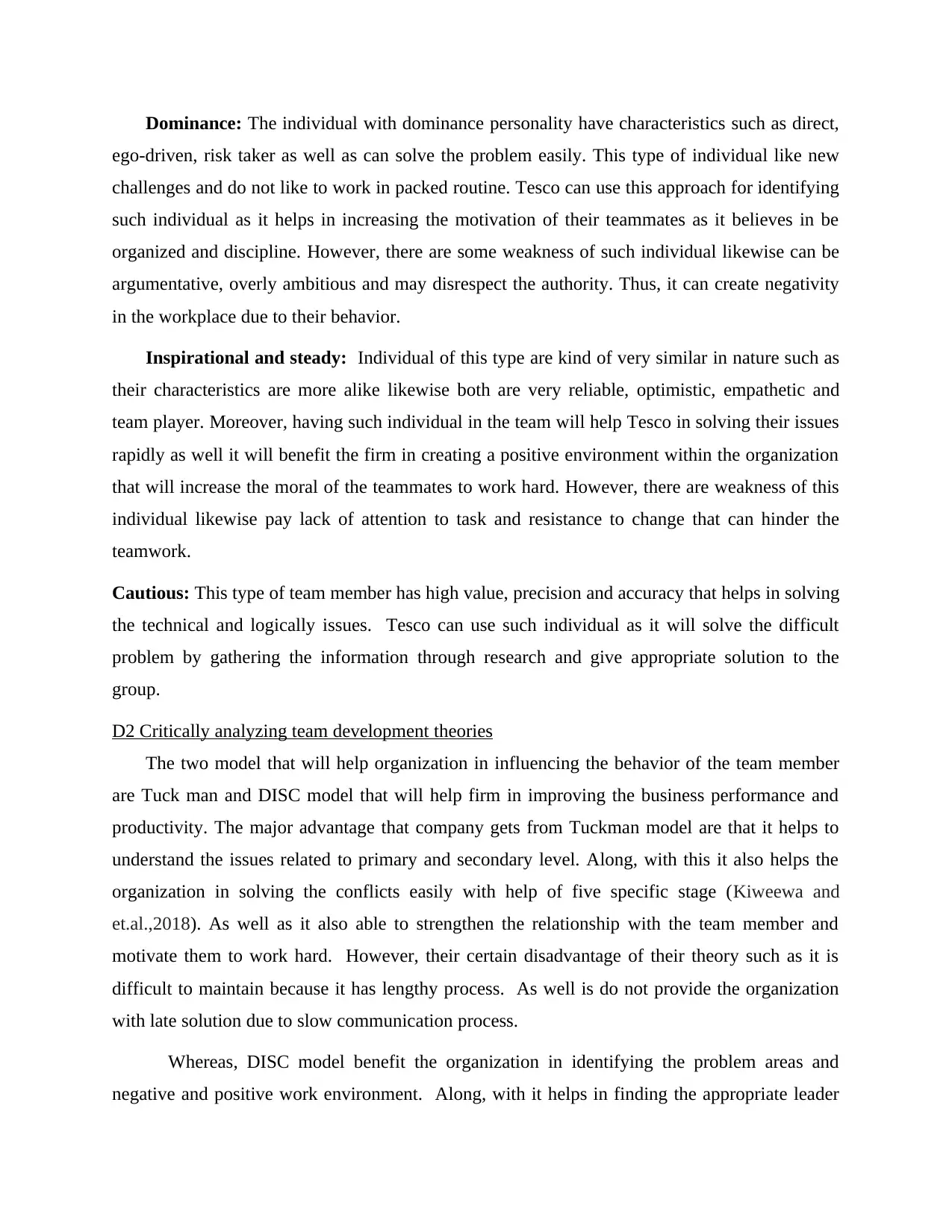
Dominance: The individual with dominance personality have characteristics such as direct,
ego-driven, risk taker as well as can solve the problem easily. This type of individual like new
challenges and do not like to work in packed routine. Tesco can use this approach for identifying
such individual as it helps in increasing the motivation of their teammates as it believes in be
organized and discipline. However, there are some weakness of such individual likewise can be
argumentative, overly ambitious and may disrespect the authority. Thus, it can create negativity
in the workplace due to their behavior.
Inspirational and steady: Individual of this type are kind of very similar in nature such as
their characteristics are more alike likewise both are very reliable, optimistic, empathetic and
team player. Moreover, having such individual in the team will help Tesco in solving their issues
rapidly as well it will benefit the firm in creating a positive environment within the organization
that will increase the moral of the teammates to work hard. However, there are weakness of this
individual likewise pay lack of attention to task and resistance to change that can hinder the
teamwork.
Cautious: This type of team member has high value, precision and accuracy that helps in solving
the technical and logically issues. Tesco can use such individual as it will solve the difficult
problem by gathering the information through research and give appropriate solution to the
group.
D2 Critically analyzing team development theories
The two model that will help organization in influencing the behavior of the team member
are Tuck man and DISC model that will help firm in improving the business performance and
productivity. The major advantage that company gets from Tuckman model are that it helps to
understand the issues related to primary and secondary level. Along, with this it also helps the
organization in solving the conflicts easily with help of five specific stage (Kiweewa and
et.al.,2018). As well as it also able to strengthen the relationship with the team member and
motivate them to work hard. However, their certain disadvantage of their theory such as it is
difficult to maintain because it has lengthy process. As well is do not provide the organization
with late solution due to slow communication process.
Whereas, DISC model benefit the organization in identifying the problem areas and
negative and positive work environment. Along, with it helps in finding the appropriate leader
ego-driven, risk taker as well as can solve the problem easily. This type of individual like new
challenges and do not like to work in packed routine. Tesco can use this approach for identifying
such individual as it helps in increasing the motivation of their teammates as it believes in be
organized and discipline. However, there are some weakness of such individual likewise can be
argumentative, overly ambitious and may disrespect the authority. Thus, it can create negativity
in the workplace due to their behavior.
Inspirational and steady: Individual of this type are kind of very similar in nature such as
their characteristics are more alike likewise both are very reliable, optimistic, empathetic and
team player. Moreover, having such individual in the team will help Tesco in solving their issues
rapidly as well it will benefit the firm in creating a positive environment within the organization
that will increase the moral of the teammates to work hard. However, there are weakness of this
individual likewise pay lack of attention to task and resistance to change that can hinder the
teamwork.
Cautious: This type of team member has high value, precision and accuracy that helps in solving
the technical and logically issues. Tesco can use such individual as it will solve the difficult
problem by gathering the information through research and give appropriate solution to the
group.
D2 Critically analyzing team development theories
The two model that will help organization in influencing the behavior of the team member
are Tuck man and DISC model that will help firm in improving the business performance and
productivity. The major advantage that company gets from Tuckman model are that it helps to
understand the issues related to primary and secondary level. Along, with this it also helps the
organization in solving the conflicts easily with help of five specific stage (Kiweewa and
et.al.,2018). As well as it also able to strengthen the relationship with the team member and
motivate them to work hard. However, their certain disadvantage of their theory such as it is
difficult to maintain because it has lengthy process. As well is do not provide the organization
with late solution due to slow communication process.
Whereas, DISC model benefit the organization in identifying the problem areas and
negative and positive work environment. Along, with it helps in finding the appropriate leader
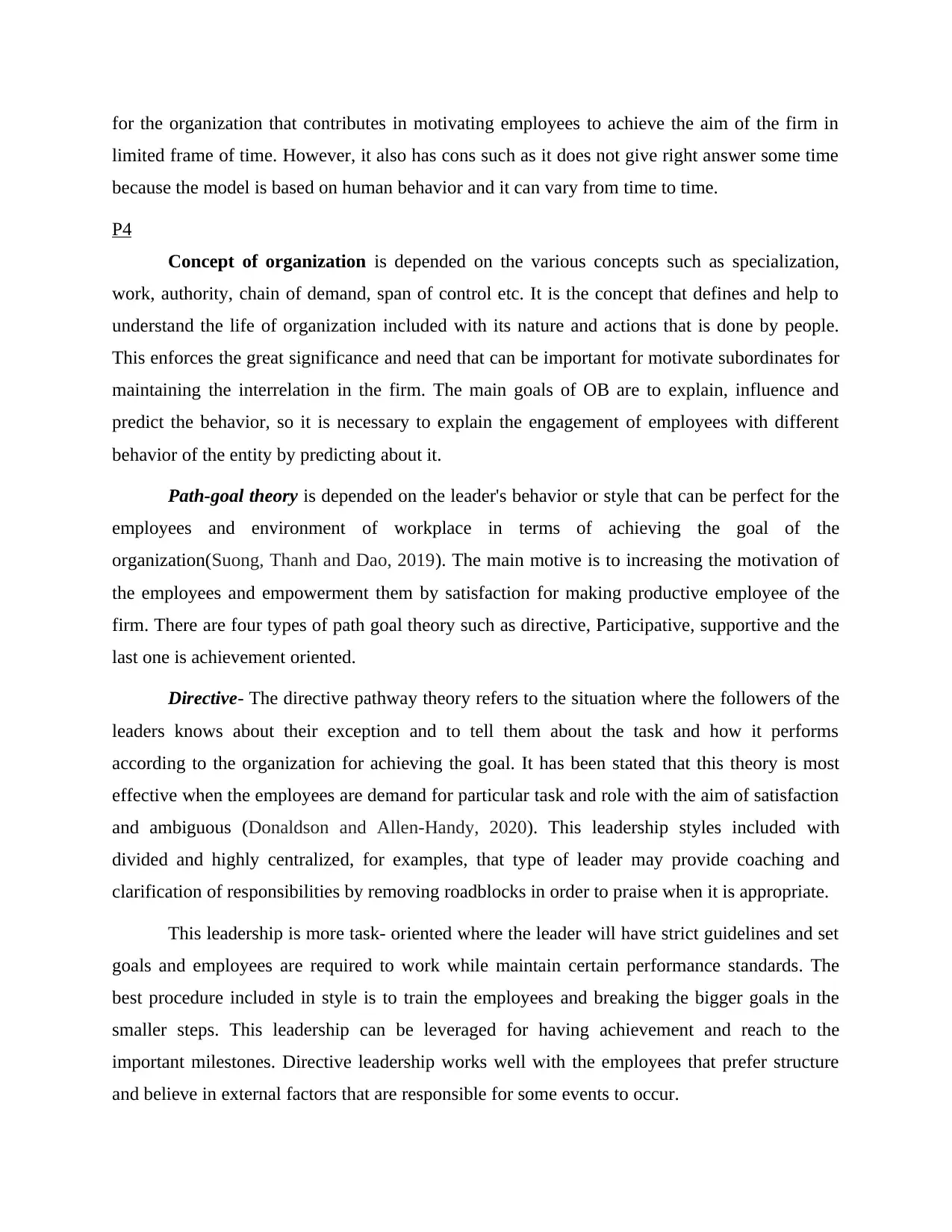
for the organization that contributes in motivating employees to achieve the aim of the firm in
limited frame of time. However, it also has cons such as it does not give right answer some time
because the model is based on human behavior and it can vary from time to time.
P4
Concept of organization is depended on the various concepts such as specialization,
work, authority, chain of demand, span of control etc. It is the concept that defines and help to
understand the life of organization included with its nature and actions that is done by people.
This enforces the great significance and need that can be important for motivate subordinates for
maintaining the interrelation in the firm. The main goals of OB are to explain, influence and
predict the behavior, so it is necessary to explain the engagement of employees with different
behavior of the entity by predicting about it.
Path-goal theory is depended on the leader's behavior or style that can be perfect for the
employees and environment of workplace in terms of achieving the goal of the
organization(Suong, Thanh and Dao, 2019). The main motive is to increasing the motivation of
the employees and empowerment them by satisfaction for making productive employee of the
firm. There are four types of path goal theory such as directive, Participative, supportive and the
last one is achievement oriented.
Directive- The directive pathway theory refers to the situation where the followers of the
leaders knows about their exception and to tell them about the task and how it performs
according to the organization for achieving the goal. It has been stated that this theory is most
effective when the employees are demand for particular task and role with the aim of satisfaction
and ambiguous (Donaldson and Allen-Handy, 2020). This leadership styles included with
divided and highly centralized, for examples, that type of leader may provide coaching and
clarification of responsibilities by removing roadblocks in order to praise when it is appropriate.
This leadership is more task- oriented where the leader will have strict guidelines and set
goals and employees are required to work while maintain certain performance standards. The
best procedure included in style is to train the employees and breaking the bigger goals in the
smaller steps. This leadership can be leveraged for having achievement and reach to the
important milestones. Directive leadership works well with the employees that prefer structure
and believe in external factors that are responsible for some events to occur.
limited frame of time. However, it also has cons such as it does not give right answer some time
because the model is based on human behavior and it can vary from time to time.
P4
Concept of organization is depended on the various concepts such as specialization,
work, authority, chain of demand, span of control etc. It is the concept that defines and help to
understand the life of organization included with its nature and actions that is done by people.
This enforces the great significance and need that can be important for motivate subordinates for
maintaining the interrelation in the firm. The main goals of OB are to explain, influence and
predict the behavior, so it is necessary to explain the engagement of employees with different
behavior of the entity by predicting about it.
Path-goal theory is depended on the leader's behavior or style that can be perfect for the
employees and environment of workplace in terms of achieving the goal of the
organization(Suong, Thanh and Dao, 2019). The main motive is to increasing the motivation of
the employees and empowerment them by satisfaction for making productive employee of the
firm. There are four types of path goal theory such as directive, Participative, supportive and the
last one is achievement oriented.
Directive- The directive pathway theory refers to the situation where the followers of the
leaders knows about their exception and to tell them about the task and how it performs
according to the organization for achieving the goal. It has been stated that this theory is most
effective when the employees are demand for particular task and role with the aim of satisfaction
and ambiguous (Donaldson and Allen-Handy, 2020). This leadership styles included with
divided and highly centralized, for examples, that type of leader may provide coaching and
clarification of responsibilities by removing roadblocks in order to praise when it is appropriate.
This leadership is more task- oriented where the leader will have strict guidelines and set
goals and employees are required to work while maintain certain performance standards. The
best procedure included in style is to train the employees and breaking the bigger goals in the
smaller steps. This leadership can be leveraged for having achievement and reach to the
important milestones. Directive leadership works well with the employees that prefer structure
and believe in external factors that are responsible for some events to occur.
⊘ This is a preview!⊘
Do you want full access?
Subscribe today to unlock all pages.

Trusted by 1+ million students worldwide
1 out of 16
Related Documents
Your All-in-One AI-Powered Toolkit for Academic Success.
+13062052269
info@desklib.com
Available 24*7 on WhatsApp / Email
![[object Object]](/_next/static/media/star-bottom.7253800d.svg)
Unlock your academic potential
Copyright © 2020–2025 A2Z Services. All Rights Reserved. Developed and managed by ZUCOL.



